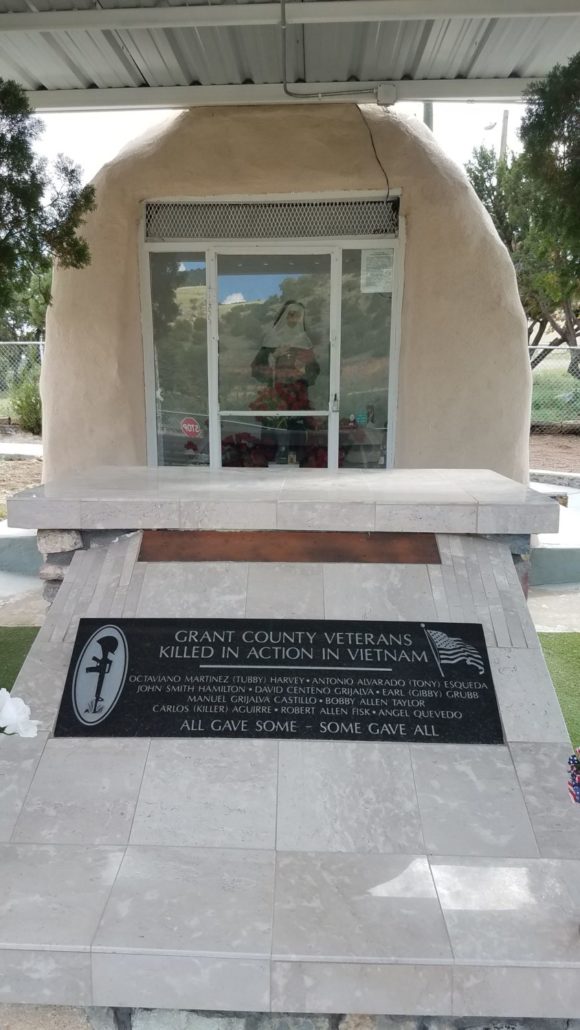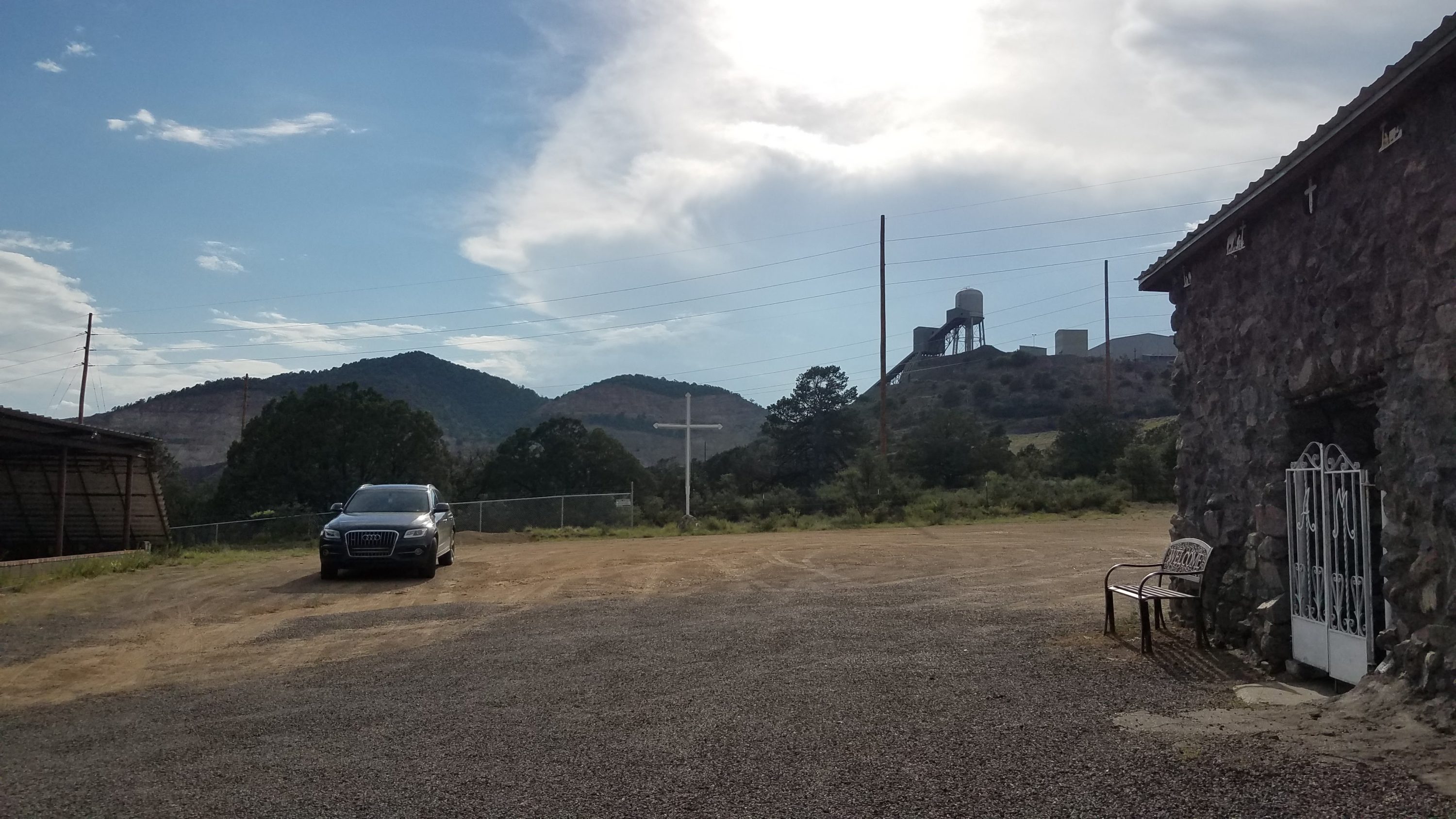We stood silently in the Capilla, the weight of generations of prayers layered on one another pressed down on our shoulders. Jesus stared through us. Three hundred votives flickered in the darkness of the hand-placed stones that built up the walls, and prayers written on notebook paper stuffed the fissures of the hidden fortress, and picture of young boy printed from a laser printer and the blue ink scratched, “Do not remove until June 2007.”
Overhead, we heard the bulldozers pushing mounds of earth precariously across the 45-degree angled surface of Hanover Mountain. A crane planted itself firmly at the top, some 80-feet lower now than where the 10-foot wooden cross once stood. It hauled the marrow of the earth up over the hill and into the unknown. Fierro was once a lively mining town. Now it is a name on a map along an unmarked road marred by the decaying remains of homes. The only building preserved against dry rot is El Sancuario de la Pieta at St. Anthony’s Catholic Church. People still travel twice per month to attend mass at St. Anthony’s. We had arrived right in time for the ceremony, but the doors were locked and the only chorus to be heard rumbled from the stomach of the mine–the mountain shaved to its core.
“There is no church this Sunday,” Zakery said, “They’re moving the mountain.”
This newest eviction in the long line of environmental injustices in the Grant County mining district. The mine that swallowed the town of Santa Rita as its pit expanded was about to engorge the memorial shrine of Fierro too.

The Shrine of Santa Rita sits tucked in a battlefield of dying towns at the intersection of New Mexico highways 152 and 356. In exchange for their loss, the residents of Santa Clara were gifted a 900-square foot lot to fence in their refugee relics: Our Lady of Guadalupe stands in here a terrarium holding a rosary and overlooking a memorial to Grant County Veterans. She herself stands as a memorial praying for the Santa Rita refugees whose lives and homes destroyed. Across the pews, looking south toward exposed rainbow earth, a plaque reads:
In 1960, Kennecott Copper Corporation notified the residents of the town of Santa Rita that they had to evacuate by 1970 due to mining expansion, all houses, buildings, and the Santa Rita Catholic church were either moved or demolished. The Statue of Santa Rita was taken the village of central Miguel Ojinaga. Angel Alvarado and Moy Gonzales asked Kennecott for a section of land, and the statue was brought back with the blessing of the diocesan of El Paso and with the help of other Santa Rita residents. The shrine was built here.
The plaque speaks in half-truths about the devastations of the people, as though the plot of land smaller than the average backyard is a gift. The residents of Santa Rita did not evacuate, an optional migration in the event of natural disaster, they were evicted by their Land Lord. As the earth literally fell out from under their feet took, not only where they lived but where they went for spiritual rejuvenation, citizens of Santa Rita were left with nothing. They waited and watched the physical destruction of their town, only to see a symbol of their faith carried off in the process. Our Lady of Guadalupe, a cultural symbol for the Mexicano people sought refuge in El Paso waiting out her trial for permission to return. Now, she mourns over all of the lives lost in Grant County. The physical lives of veterans and the envision of life as it once was. Soon there would be a new memorial statue to honor the 890 women’s auxiliary who put their lives on the line in 1950 to fight for fair working conditions in the same mine. The Santa Rita shrine is a catch-all sanctuary because it is the untouched slice of a “home” they used to know. It is a cultural artifact of the little bit they could salvage.

As Glenn Albrecht explains in “Solastalgia: A New Concept in Health and Identity” the citizens of Santa Rita grieved as they watched their lands being stripped away. They felt a “relationship between the psychic identity and their home. What these people lacked was the solace of comfort derived from their present relationship to ‘home’.” The destruction of one’s land is the devastation of one’s identity, especially in a mining town where the earth is tied to their culture. The people call themselves the Salt of the Earth, both in reference to their humble nature and their inseparable identity from the ground that provides for them. The paradox of mining is knowing that you make your money exploiting the same resources you depend on for sustenance. Although the company houses did not belong to the people of Santa Rita, the land always did. When the company asserted its power to repossess all of the lands, they left families defenseless–homesick, mourning.
Much like Albrecht notes, “their place-based distress was also connected to a sense of powerlessness and a sense that environmental injustice was being on home.” They watched pit expand to consume their geographic homes, and their vision of home was destroyed as they realize how little power they had over anything. This grief is intensified knowing the Santa Rita citizens where the ones both assaulting and assaulted. They dugs the pit during the day and came home the sleep in houses they would sweep away. They understood that their paychecks would cost the people of Santa Rita their lives as they knew it.
Now Santa Rita is a whisper behind a chain-linked fence, and Fierro is dwindling as the pit runs dry. The only hope of saving the central mining district is mountain-top removal.
